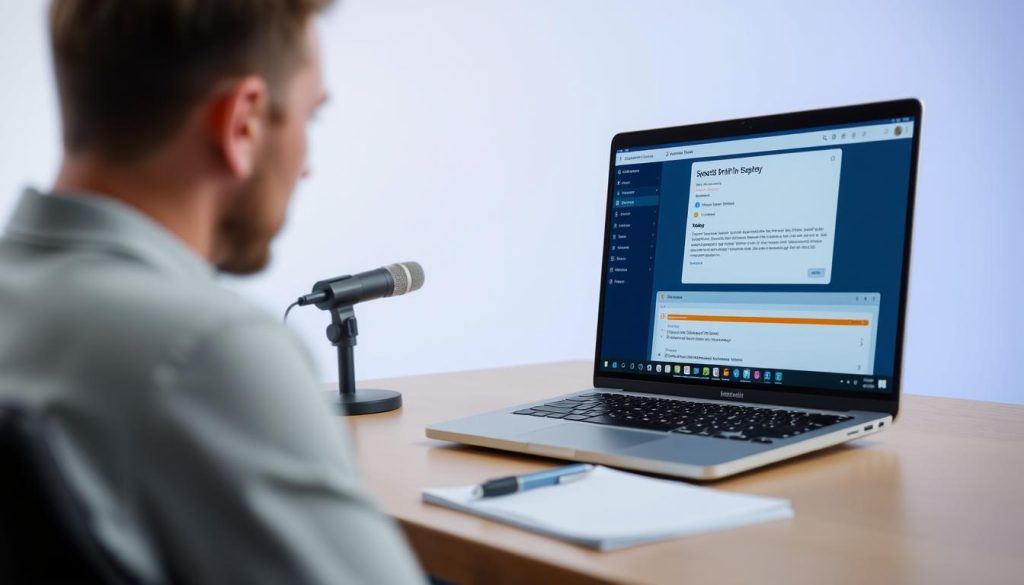Can you upload an interview and get a clean transcript in seconds—without setup or slow manual work?
We built a browser-based solution so you can move from raw audio or video to searchable text in minutes. Upload common media formats like mp3, wav, mov, mpg, or avi and get a transcript link quickly.
We focus on accuracy and speed. Our software supports timestamps, speaker labels, and in-editor edits so you spend time on insight, not cleanup.
Start with no account or credit card, process files up to 2GB during trial, and export TXT, PDF, DOCX, or SRT. Then share via email, link, or integrated apps such as Notion, Salesforce, and Zapier.
Whether you handle a single interview or a batch, this technology keeps quality consistent and helps you turn quotes into publishable content fast.
Key Takeaways
- Upload audio or video and receive a transcript link within seconds or minutes.
- Browser-based software needs no downloads and supports common media formats.
- Exports include TXT, PDF, DOCX, and SRT for flexible publishing.
- Built-in timestamps and speaker labels help maintain accuracy and structure.
- Start instantly with no credit card and integrate with tools like Notion and Zapier.
AI transcription for interviews: what businesses gain today
Turning long audio and video files into usable text in minutes transforms how teams act on insights.
Time-saving and consistency for modern teams
We cut the time your team spends on interview transcription by delivering near-instant results and a clear workflow that removes manual steps.
The browser-based editor makes proofreading quick. You get timestamps, speaker labels, and fast find-and-replace so you edit words without replaying long clips.
Trials include the first 30 minutes free and support many formats with uploads up to 2GB during trial—so long recordings move through the same process.
From audio and video to searchable text in minutes
Upload an audio or video file and receive a searchable transcript within seconds or minutes. Export options (TXT, PDF, DOCX, SRT) and sharing via email, link, or integrations get content to users fast.
“The simple process—upload, receive, edit, and share—keeps work moving without bottlenecks.”
- Move from capture to delivery quickly—this is the best way to protect data integrity and save time across research and reporting.
- Built-in features standardize documents so every department reads the same transcript.
- Support for long-form audio video assets keeps your process consistent as projects scale.
Who benefits from interview transcription services
When words matter, fast searchable records cut verification time and lock down accurate quotes.
Journalists and podcasters get exact quotes with timestamps and speaker labels. That saves rewrite time and removes the need to replay long recordings for verification.
Human resources teams centralize interviews in a secure workspace. You get consistent, searchable records that are easy to export and audit when policies require proof.
Researchers and professional transcriptionists scale work without losing context. Advanced speaker detection aligns words and moments so notes stay accurate across many interviews.
Creators and educators turn conversations into captions, lesson scripts, and YouTube-ready content. Auto-subtitle workflows and export formats speed publishing.
- Real-time collaboration with View/Edit permissions keeps your team synced and prevents version drift.
- Users can attach notes, flag segments, and collect voice-driven insights in one place.
- Support for long audio and video files means panel discussions and long-form recordings process without chopping files.
“Fast, accurate records let teams move from recording to reporting with confidence.”
How our AI interview transcription process works
Fast, predictable results let you turn recorded conversations into usable documents without friction.
Upload a recording in its original format and move straight to editing—no prep needed.
Upload your audio or video—common formats supported
Start transcribing by adding mpg, avi, wav, mov, or mp3 files. You do not need to convert media first.
We accept long recordings and multiple files in one session. During trial, individual file size is limited to 2GB.
Receive an auto-generated transcript in seconds or minutes
Our process analyzes the recording and returns a transcript link quickly. That link gives you instant access to a searchable text version.
This speed helps teams move from capture to review without waiting on back-and-forth transfers.
Edit, search, and share—all in your browser
Work entirely in the browser: jump to timestamps, assign speakers, and edit every word with minimal clicks.
- Share via email, secure link, or push to Notion, Salesforce, and Zapier.
- Export to TXT, DOCX, PDF, or SRT for drafting, review, and captioning.
- Behind the scenes, our technology combines speaker detection and automated timestamps to speed edits while keeping accuracy high.
Key features that streamline interview transcription
A focused set of tools streamlines how you process files, label speakers, and export final transcripts.
Interactive text editor with timestamps and speaker labeling
Work directly in the editor to jump by timestamp, correct wording, and assign each speaker fast. The interface highlights voice changes and shows audio waveforms so you can match text to voice with minimal clicks.

Multitrack support and AI speaker detection for panel interviews
Handle multiple channels and merge audio and videos into one clean transcript. AI speaker detection speeds labeling so you spend less time tagging and more time refining narrative flow.
Export formats: TXT, PDF, DOCX, SRT
Export a transcript in the formats you need—TXT, PDF, DOCX, or SRT—without extra conversion steps. That keeps publishing, captioning, and archival work simple and fast.
Team collaboration, permissions, and API access
Share via email, link, or integrations like Notion, Salesforce, and Zapier. Role-based View/Edit permissions keep edits controlled. Use our API to automate ingest, process large files, and pull transcripts into your CMS or BI tools.
Languages, accessibility, and content reach
Make recorded media accessible to more people by converting voice and sound into clear text and captions.
Transcribe and translate in 50+ languages, with select tools supporting 100+ languages so your team can publish multilingual content without extra steps.
Generate auto subtitles and captions in up to 125+ languages to help viewers who watch without sound or who need text support.
Integrations and workflow
Connect your YouTube channel to fetch videos automatically. Link Zoom to import recordings without manual uploads.
Produce text and captions in the same workspace, then publish across platforms with no reformatting.
Accuracy and accessibility controls
Our cloud-based software keeps media and transcripts secure while teams collaborate from anywhere.
- Audio video alignment and line-length controls make captions read naturally.
- Consistency checks keep names and key words accurate across languages.
- Voice-friendly models are tuned for clarity so your content remains inclusive.
“Auto subtitles in many languages expand reach and improve accessibility for every viewer.”
Speed, accuracy, and reliability versus manual transcription
When speed matters, modern systems turn hours of audio into editable text in minutes without sacrificing consistency.
AI delivers 95–97% accuracy in a fraction of the time
We deliver 95–97% accuracy in minutes, making this the best way to transcribe detailed interview material without days of retyping and QA. In-browser editing lets you correct a few words quickly while the recording plays.
Consistent quality across long-form interviews
Quality stays steady across hours of recording, even when speakers change pace or style. Timestamping plus speaker identification reduces cleanup to targeted edits, not full rewrites.
- Fast, near-instant results cut time-to-delivery and project costs.
- Scales from single files to backlogs without losing accuracy.
- Add one compliance pass to meet legal or style standards without delaying publication.

Pricing, trials, file sizes, and data handling
Get started instantly—no account, no card—and validate the workflow with your own files.
Start free: no credit card or account required
Start free—no credit card or account needed. You can transcribe interview recordings and confirm fit before you commit budget.
Trial specifics: first 30 minutes free; up to 2GB files during trial
The trial includes the first 30 minutes free and accepts uploads up to 2GB per file. That makes it easy to test with long sessions or large media files.
You can upload audio files and videos of any duration after trial, so production workflows stay uninterrupted.
Secure storage, easy sharing via links, email, and app integrations
We secure your data with encrypted storage. Files and transcripts can be deleted with a single click to meet compliance needs.
Export in common formats (TXT, PDF, DOCX, SRT) and share via link, email, or connected apps like Notion, Salesforce, and Zapier.
- Start free—no credit card—so you can transcribe interview material and validate fit quickly.
- Trial: first 30 minutes free; 2GB per file during the trial period.
- Export transcripts in needed formats and push SRT for caption workflows.
- Encrypted storage, easy deletion, and app integrations keep data moving securely.
Conclusion
Conclusion
When you need clear, shareable records, a unified online tool keeps every transcript accessible and secure.
We help you transcribe interviews quickly, export multiple formats, and push text into YouTube captions, Notion, Salesforce, or Zapier. Start free with 30 minutes and no credit card needed to validate quality and fit.
For long interview sessions, timestamps and speaker labels make it easy to pull quotes and polish each word. Standardized interview transcripts scale with your team so content reuse and compliance stay simple.
If you want to move faster, this is the best way to turn recorded interviews into accurate transcripts and publishable text that saves time and keeps projects on schedule.

Leave a Reply